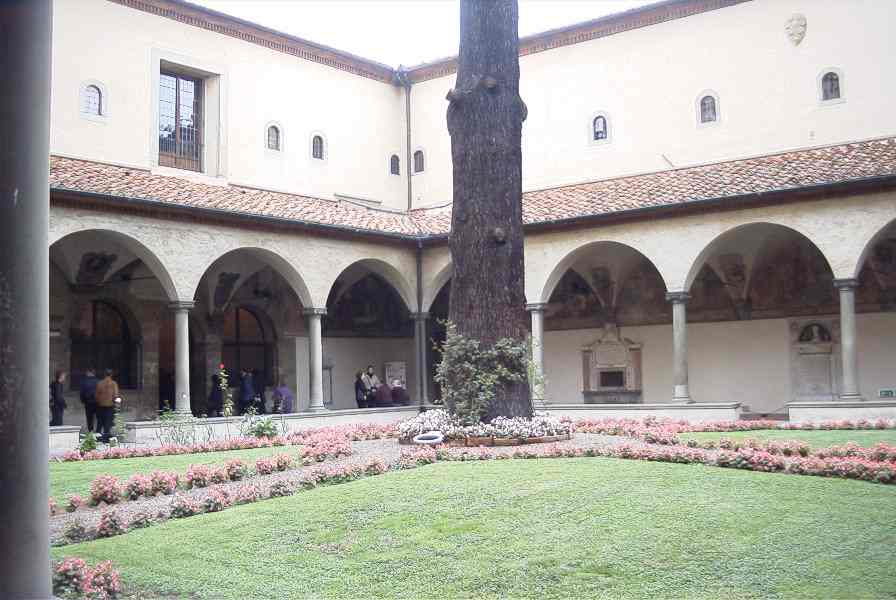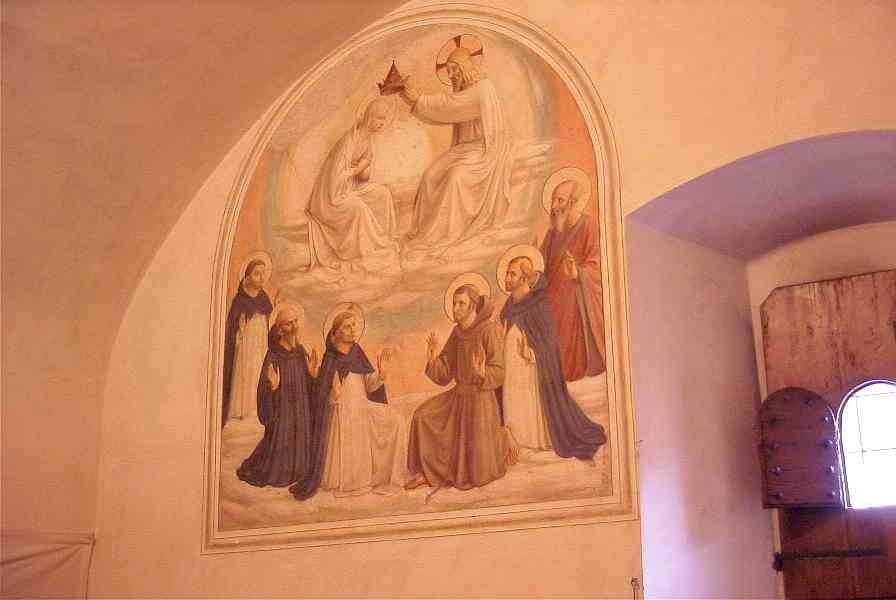

Our first night in Florence was quiet; quieter than our Paris apartment as we were south of the Arno in the garden area of Florence. At breakfast we found ourselves virtually alone in the hotel -- a shame as the help was gracious, the rooms spacious and the breakfast continental but ample. After breakfast we figured out how to take the bus into town and soon we arrived at our first destination, Convento Di San Marco -- St. Mark's Convent.
After spending a few minutes in the adjoining St. Mark's Church to avoid one of the few tourist-bus lines we encountered in Florence, we entered the cloister seen at the top of the page. As we soon found out, almost every Florence church seems to have such an arched cloister. This outside hallway is the launching point for several rooms filled with religious frescos. Around the cloister on the second floor are the monks cells.
While this is a very simple building, it shows the difficulty Florence has in doing anything simple in the 15th century with a Medici around. Late 15th century Florence had more woodcarvers than butchers.
St Mark's had several famous residents, but its most artistic inhabitant was Fra Angelico, a modest Dominican (and eventual saint) who lived here ten years in between being summoned to Rome to paint Papal chapels . While here, he seems to have continually painted his brother monks walls as nearly every room is filled with his frescoes like the one below, meant to inspire its monk to spiritual excellence:

To get to the cells, you climb the stairs, only to find at the top one of Fra Angelico's most famous paintings, the Annunciation , protected by Plexiglas since the fresco can't be moved. It's a little shocking to see something you expect to be well protected in a museum right in front of your nose.

While I don't have any more pictures of this convent worth showing, this web page should satisfy your craving for Fra Angelico. http://gallery.euroweb.hu/html/a/angelico/sanmarco/ . Angelico was followed by another fresco-frenzied monk, Fra Bartolomeo. While their collective work is considerable inside this building, their influence on other artists was minimal as these were private rooms not open to the public. It opened to the public finally in 1869; in the past twenty years, many of the frescoes have been restored.
It is debatable how much influence Angelico would have had anyway: with the Renaissance raging around him, his painting stayed fairly true to the Gothic tradition.
The convent was paid for by another of its famous (if temporary) residents, Cosimo the Elder, the founder of the Medici clan. He had his favorite architect Michelozzo redesign it. He kept two simple rooms inside so that when he got too frustrated with the Florentine politics, he could hide out inside. In addition, he had installed here the first public library in Europe.
Another famous tenant was both head of Florence after becoming head of the convent -- the Dominican Savonarola who preached against the decadence of Florence and the Medicis, predicted the onslaught of the French to humble the town, burnt books and art works (and a lot of stuff that deserved burning) on the town square, and then was himself hanged and burnt on the same spot a year later. His rooms are a mini-museum inside the convent.
Our next stop was the Galleria Dell'Accademia, Michelangelo's David's new home. Please Join us by clicking here.
Where do you want to go today? Here's a few choices:
